Home >Technology peripherals >AI >Say goodbye to the AI era of handlooms
Say goodbye to the AI era of handlooms
- 王林forward
- 2023-04-19 10:28:02808browse
In the 1860s, when the steam engine was invented, most people did not realize that the "industrial revolution" was coming;
When ENIAC came out in 1946, people also did not realize that computers would Half a century later, it has become the infrastructure that supports social operation and technological innovation;
Even in 2005, people could not imagine that almost all needs for food, clothing, housing and transportation could be solved with just a mobile phone without cash; without A separate camera can also record everything around you anytime and anywhere.

Whenever a disruptive technology is born, people always underestimate its impact on the social economy. Only when history is summarized decades later, its impact value will be defined.
As Bill Gates said: We always overestimate what we can do in one year and underestimate what we can do in five or ten years.
Now, the protagonist is "artificial intelligence".
In 2022, the AI industry chain will be initially improved, and demands from various industries will continue to emerge. Practitioners are holding high the banner of "AI entering thousands of industries" to expand the market, and some pioneers have even successfully IPO'd.
Cost reduction and efficiency increase, digital transformation, digital economy... have become hot words related to the current AI industrialization. Leading the fourth industrial revolution and the iteration of productivity, these values of AI are recognized by many parties.
But no one can clearly describe the AI landscape 10 years from now or 50 years from now. Whether the development of AI will be what we predict and define today -
With our current vision, we cannot give an accurate answer.
Facing the sea of stars and AI, we have just left the surface of the earth.
Living in the whirlpool of industrial change, it may be difficult to see the endgame of AI, but the "ultra-large scale" and "refinement" of AI algorithms are at least the only way to this endgame.
Under the trend of ultra-large scale and refinement, AI urgently awaits the industrial revolution
The so-called ultra-large scale means that AI algorithms are everywhere -
Number of algorithms Like the number of APPs, it will grow explosively, penetrate into every detail of production, work, and life, and become an important asset for urban management and enterprise development.
Just as there are millions of APP types in today’s smartphone app stores, algorithms cover almost all needs of all types of people and all walks of life. Many of them have become part of our daily life.
The so-called refinement means that the functions of a single AI algorithm will become more and more subdivided, and countless small AI algorithms will be combined into extremely complex systems based on the usage requirements of different industries, different scenarios, and different devices. High AI applications.
Under this trend, soon every AI application we take for granted may become a complex intelligent agent composed of hundreds or thousands of algorithms.
Refinement will also bring about the scenario-based AI. In other words, it is necessary to train AI algorithms suitable for different vertical and segmented scenarios based on the actual situation and demand characteristics of the customer.
However, as scenarios continue to be explored, the number of customized demands from customers will also surge rapidly, which will bring more challenges to the implementation of AI. Special customization for each demand will not only increase costs, but also Slow down the landing cycle.
Looking only at the field of community management, algorithm requirements include a large number of detailed requirements such as garbage overflow, high-altitude thrown objects, mask detection, vehicle illegal parking identification, electric vehicles entering elevators, residents falling, and people trapped in elevators. The same goes for manufacturing, energy and other fields.
The same model has different applicability in different scenarios.
Take flame and smoke recognition as an example. If it is placed on a community street, there is no need to call the police if someone lights up a cigarette. If it is placed on a construction site, there is no need to alert if sparks are as big as electric welding. However, at a gas station, the demand becomes even if there is a spark. Let it go.
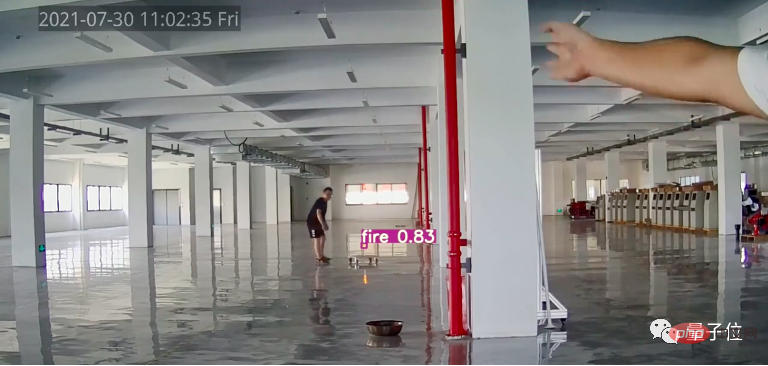
#Although these scenarios bring a lot of fragmented long-tail demands to the algorithm, they are still an indispensable part of intelligent community management.
However, this type of long-tail scenario has a significant feature, that is, sample data is scarce, and high-quality data sets that can be used for training are even more luxuries.
Therefore, during the development process, it is often necessary to collect data on site for initial training, and continue to iterate after the algorithm is online. Only experienced algorithm engineers can train an algorithm with good accuracy under a limited amount of data.
Under the trend of "ultra-large scale" and "refinement", the terminal deployment adaptation of AI algorithms is another hidden pain point in the implementation of AI.
If the algorithm is to be used effectively, chip adaptation is a necessary process.
This work is carried out by writing development tool kits for different tool chains for different chips, and quantitative adjustments should be made to the performance of the terminal chip to maximize the utilization of the chip.
Currently, most AI companies in the market only adapt to mainstream brands such as NVIDIA and Qualcomm and self-developed chips. If the chip used by the user is not within the adaptation range, it will cost at least 2 to 3 months extra. Time is required for separate adaptation. Even so, the utilization rate of the chip may still be less than 10%, resulting in a huge waste of resources.
In the traditional development model, from the definition of business problems, to the collection and labeling of data, the design, parameter adjustment, training, and tuning of algorithm models, to the chip adaptation and performance evaluation of the model——
The entire chain is not only complicated and has a long cycle, but also requires a lot of manual participation. The entire process usually takes several months. The uncertainty of algorithm utilization will increase the cost of computing power.
This kind of craftsmanship spirit that "must be artificial to be intelligent" will be unable to cope with the massive demand in the future.
It is impossible to leave the surface of the earth by rowing a boat by hand. Everyone expects AI to bring about the fourth industrial revolution and liberate more labor-intensive jobs, but AI itself has become a labor-intensive industry. Who will liberate the repetitive work of a large number of research institutes and engineers?
In addition, in order to deepen the implementation of the industry, we also need to make choices in the game between standardization and customization.
Previously, algorithm SDKs and SaaS services were popular, and many companies hoped to gradually standardize their products and achieve scale development. It turns out that the deeper AI penetrates into the industry, the more fragmented and non-standardized the demand becomes. Relying on a single model to universally solve all problems is an unworkable business model.
Customized solutions and general contract integration projects will fall into the dilemma of high costs, low profits, and no money, making it a hard job that AI companies are unwilling to take on.
The huge gap between the supply and demand of AI industrialization and the constraints of business models require the reconstruction of productivity and production relations. AI itself also needs an industrial revolution.
AutoML, bid farewell to the AI era of handlooms
In fact, cutting-edge players have realized this sign very early and began to solve it.
Some people sent additional manpower to delve deeply into the industry, develop new algorithms one by one, join the game and strongly bind the industry, and set out to build a complete solution education market in the early stage, but ended up doing a lot of integration work.
Some people have also set up supercomputing centers to build large models and large devices, hoping to solve all problems at once.
There is also a new way, which not only achieves "cost reduction and efficiency improvement" of AI development, but also lowers the threshold of use and popularizes it in the industry -
Use AI to solve AI needs , whose underlying technology comes from AutoML, focuses on two words: high efficiency.
As its name suggests, AutoML refers to reducing manual participation in all stages of machine learning, turning "handmade by craftsmen" into "automated assembly line operations."
From model structural design to hyperparameter adjustment, from training to model streamlining and compression, as well as chip adaptation and deployment... Automation solutions are adopted at different stages to allow machines to replace manual labor in completing parameter adjustment and data processing. Handle complex tasks.
The core concept is to use AI to train AI.
Because AutoML will reshape the original underlying framework and cooperation model, some insiders call it: a sign of the artificial intelligence 2.0 stage.
As the proposer and early adopter of AutoML, Google has quickly made relevant arrangements. Some start-up companies have also actively carried out AutoML innovation and become practitioners in the AI industry empowering various industries.
Innovating AI’s productivity and production relationships
How efficient is AutoML when reflected in actual industrial applications?
Based on the company's automated training platform, two product managers of Shenzhen start-up company "Gongda Di" quickly trained more than 100 algorithms in only 2 to 3 weeks, covering target detection and tracking, Five major categories of visual algorithms, including image classification, semantic segmentation, posture detection, and 3D detection, cover 80 fragmented application scenarios and 70 AI chips.
In simple terms, it originally took at least half a year from algorithm development to deployment. Now, with automated methods, it can be completed in half a day, and the efficiency has increased exponentially.
However, to fully bring AutoML to the commercial market, we need to start from the perspective of customer value, help customers get started quickly at a lower cost, and create productivity innovation; at the same time, link the upstream and downstream industries to optimize the industry's supply and demand system. , to achieve the reshaping of production relations.
First of all, it is the innovation of productivity.
Although AutoML is known as "automatic", for product managers, data analysts and other groups with non-AI technology background, it is still a headache tool that "cannot understand".
Unlike technology giants who only use it to improve the work efficiency of internal technical personnel, Gongdadi carries out full-chain automation transformation in the development pipeline, so that business personnel who do not understand AI can also use AI, greatly reducing the cost of AI. Use threshold to create unlimited AI productivity behind your enterprise.
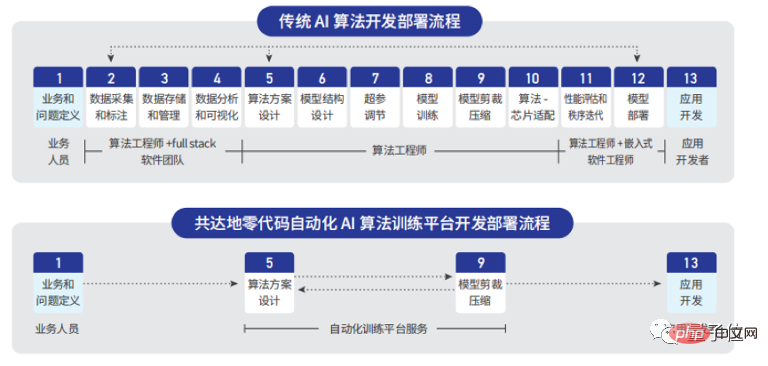
As can be seen from the picture, the whole process of Gongdadi has achieved 0 code and low threshold. Using AutoML to train the AI they want, users only need to simply click the button. , you can upload training data self-service according to your own needs, and the platform can independently complete model design, training and parameter adjustment, and can train a high-quality AI vision algorithm in a short time.
Currently, the platform has covered more than 90% of common tasks in the industry, with major categories covering: detection, segmentation, classification, human body, 3D and other algorithms. Data collection and annotation can also be handed over to Gongda partners. Product managers and business experts only need to be responsible for defining the requirements and can quickly complete the implementation, realizing "definition is what you get".
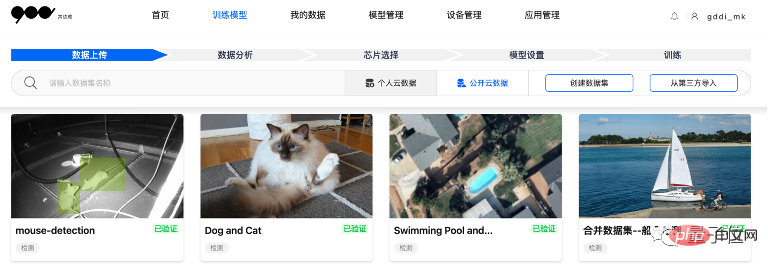
Since in reality, many small and medium-sized enterprises have urgent needs for fragmented scenario algorithms, the team also joined forces with data vendors to quickly launch an automated "algorithm mall"——
Allow customers to quickly apply AI algorithms to their own business chains in a 0-code, plug-and-play manner to achieve intelligent upgrades.
Currently, this mall contains nearly a hundred scenarios and more than 5,000 high-precision algorithms adapted to more than 70 types of chips for direct use by customers.
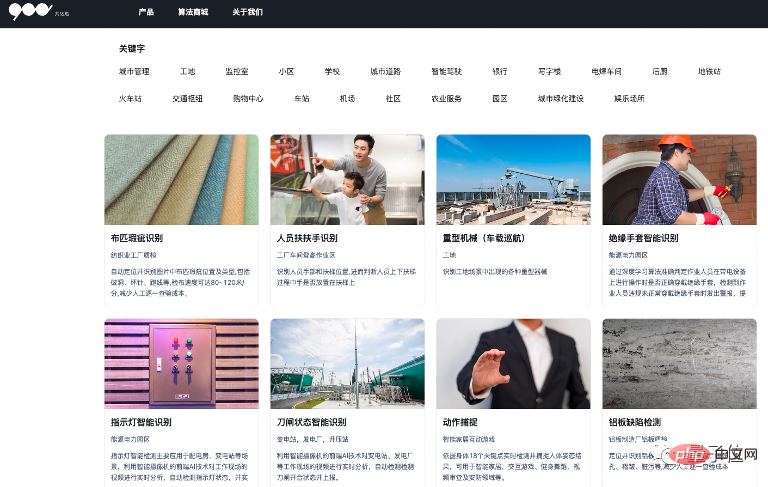
Second, it is the reshaping of production relations.
Through open empowerment, AI delivery capabilities are given to a wide range of ecological partners to jointly practice AI empowerment for all industries.
At present, the AI industry chain includes the roles of many different links such as data manufacturers, chip manufacturers, and infrastructure manufacturers. Gongda Enterprise is positioned to be open. Therefore, in the process of reshaping the industry chain through the AutoML platform , maintaining full openness to partners in all aspects.
Take the adaptation for chip manufacturers as an example.
Since different chip platforms will develop their own tool chains based on their own chip hardware architecture characteristics, during the AI model generation and deployment process, it is necessary to take into account the hardware adaptability and utilization of each different chip platform.
Gongdadi AI platform will integrate different tool chains at the SDK level to complete the adaptive conversion of the model to the terminal chip, so that the model generated by the AutoML training platform can be delivered to the terminal device with one click, and let the AI algorithm The model is fully functional.
Based on the efficiency of AutoML, Gongda has completed the pre-adaptation of almost all mainstream chips and boxes, which can increase the chip utilization to 50~60%, compared with the common industry level of 10% utilization. , greatly improving computing performance.
Not just a quantitative change, but also a singularity in industrial change
In the past, an algorithm required a group of AI engineers to develop for several months, but now one person is on the front line of the business and does not understand algorithm development. Or code programming product managers, with one click and three connections, they can efficiently independently produce high-quality algorithms according to their own needs.
AutoML brings not only quantitative changes, but also a singularity in industrial change.
Currently, more and more companies in the industry have begun to apply AutoML technology to change the AI development model. Many companies benefit from Gongdadi’s automated training platform and algorithm mall.
Based on AutoML technology, Gongdadi co-creates and builds with customers to jointly define business problems and help customers realize the efficiency of algorithms in response to the massive scenario-based AI needs in vertical and subdivided fields in various industries. Customization and distribution deployment can quickly meet various customized needs, improve development efficiency, reduce labor and R&D costs, and achieve win-win cooperation with customers.
For example, Ping An Smart City, an urban service technology company affiliated to a central enterprise, is trying to apply AutoML technology to produce multi-scenario algorithms for it.
Through Gongdadi’s automated training platform, Ping An Smart City developers can conduct fragmented scenarios such as illegal parking detection, manhole cover loss or damage detection, fireworks detection, and road occupation operation detection without coding. Algorithm model training can also be deployed end-to-end with one click. In this process, the fastest time from algorithm development to deployment is only a few hours.
Another example, in the application scenario of smart transportation, when the traffic management department of a city in Hunan Province was building related projects, Qianshitong used Gongdadi’s AutoML automated training platform to customize the “driving A series of related AI vision algorithms related to safe driving such as "not wearing seat belt recognition" and "driving phone recognition".
With almost no investment in AI algorithm engineers, the AI algorithm model training in various complex traffic scenarios was completed within two weeks.
These cases also clearly confirm the indispensability of AutoML for the ultra-large-scale and refined development of AI -
Let AI applications be integrated from just a few algorithms to just Simple agents that can complete a single task have gradually evolved into complex agents that are composed of massive algorithms and have comprehensive capabilities to complete a variety of complex tasks.
If AI is compared to an airplane, then the initial AI application is like the first airplane built by the Wright brothers. It has a simple structure and can only fly for 12 seconds. Future AI applications, like today's passenger planes that require millions of parts, can transport people from one end of the earth to their destinations on the other every day.
Just as Gongdadi's company means "reaching the destination together", while helping others succeed, you will also succeed yourself.
In this regard, Zhao Cong, founder and CEO of Gongdadi, has an interesting conclusion: To do AI, you do not necessarily need to set up an AI team.
For enterprises, through the Gongda automatic training platform, AI algorithms for fragmented mid- and long-tail scenarios can be quickly implemented. After deployment, they can also quickly optimize and iterate and continuously upgrade, thereby continuously gaining added value. .
0The low-threshold code development method also reduces the threshold for AI talents to the lowest level, empowering integrators, solution providers, and channel providers to quickly acquire reliable AI capabilities, making the development of AI algorithms no longer a problem. development burden, but turned into a weapon to improve competitiveness and efficiency.
Looking further, with the automated training platform and algorithm mall, Gongdadi does not need to step into the front line of the industry to do general contract integration projects or touch the final application. Instead, it becomes the algorithm enabler behind the enterprise and uses AI productivity and the transformation of production relations, creating new business models -
By reducing the unit application cost of AI technology, we will gradually help upstream and downstream enterprises to empower AI technology, and we will form long-term and in-depth cooperation, relying on them to enter Various industries will eventually achieve economies of scale and achieve the goal of AI empowering all industries.
Reduce unit costs and use scale effects to describe the future of AI
Looking back at the beginning, the reason why people underestimate the value brought by disruptive innovative technologies may be precisely because of this The technology has not yet achieved scale effects, and the cost of its application has not been reduced to a level acceptable to the industry.
The book "Prediction Machines" mentioned that when the price of a certain basic product drops significantly, the entire world may change.
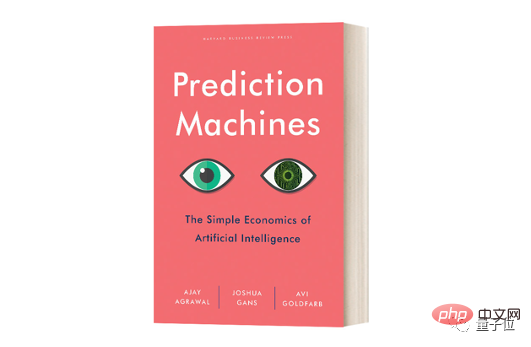
The emergence of the steam engine did not immediately ignite the industrial revolution. Instead, after the unit cost dropped and it was widely used, it ushered in the era of replacing manual labor with machines.
The emergence of tube computers did not immediately set off a scientific and technological revolution for mankind. It was not until the emergence of very large-scale integrated circuits and the gradual development of electronic design automation that PCs were truly promoted into thousands of households.
In the AI era, this scene is happening again.
Under the general trend of large-scale implementation of AI and the goal of empowering all industries, challenges are opportunities. If the traditional development path, which is costly and inefficient, is not completely changed, the lack of economics will seriously hinder the development of artificial intelligence.
With disruptive efficiency innovation, we can achieve batch and large-scale production of AI algorithms, and quickly put them into the capillaries of the industry, helping customers improve exponential performance and build core assets for digital transformation. , it is possible for AI to enter all walks of life.
We don’t pursue dazzling all the time, but we provide new ideas for the industry in a down-to-earth manner. Using technological innovation to create scale effects in AI may be the future of AI that Gongda believes in.
The above is the detailed content of Say goodbye to the AI era of handlooms. For more information, please follow other related articles on the PHP Chinese website!
Related articles
See more- Technology trends to watch in 2023
- How Artificial Intelligence is Bringing New Everyday Work to Data Center Teams
- Can artificial intelligence or automation solve the problem of low energy efficiency in buildings?
- OpenAI co-founder interviewed by Huang Renxun: GPT-4's reasoning capabilities have not yet reached expectations
- Microsoft's Bing surpasses Google in search traffic thanks to OpenAI technology

